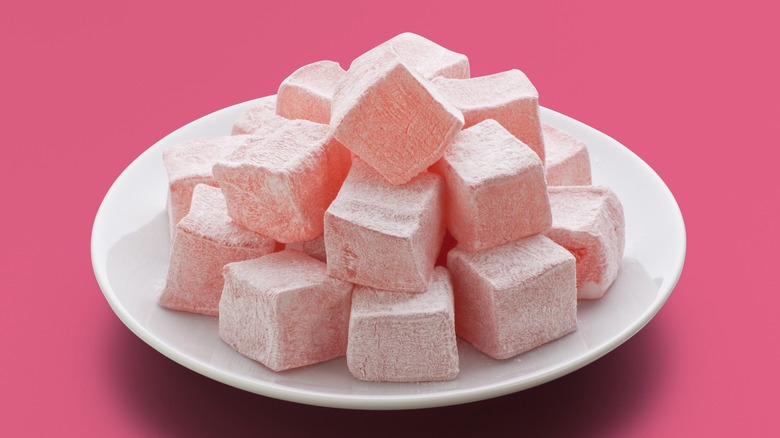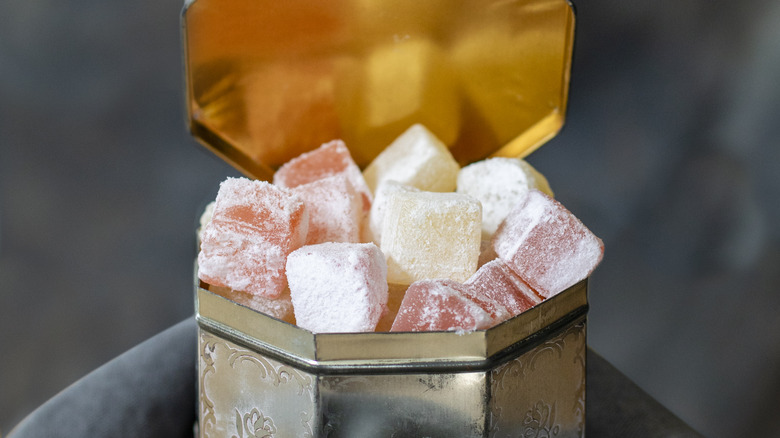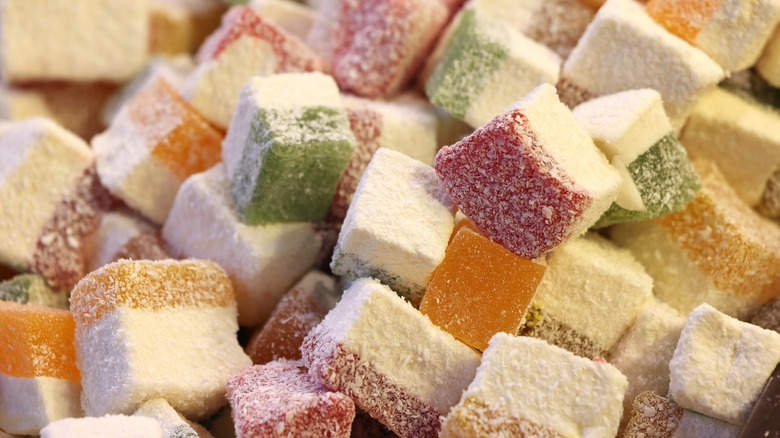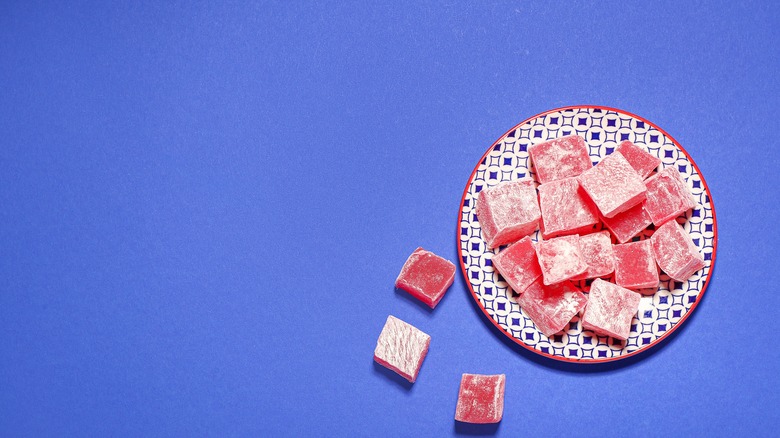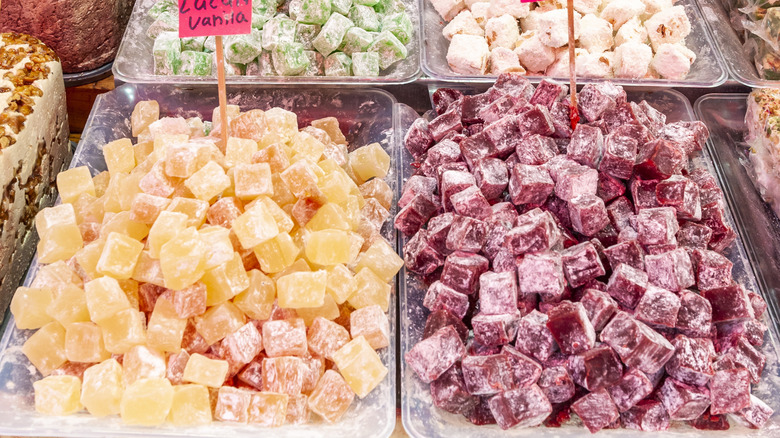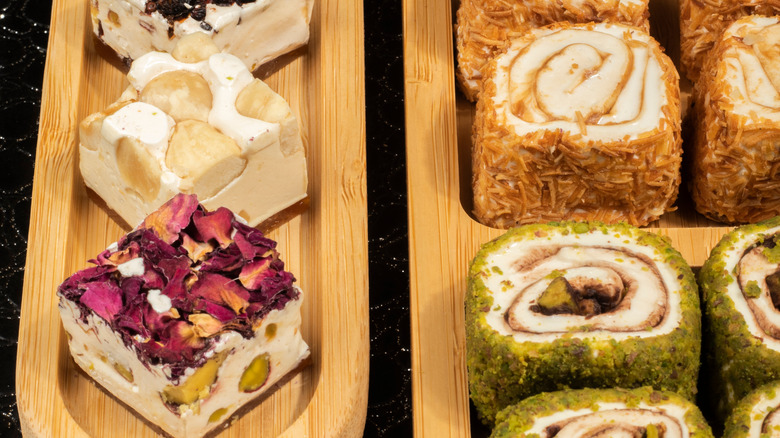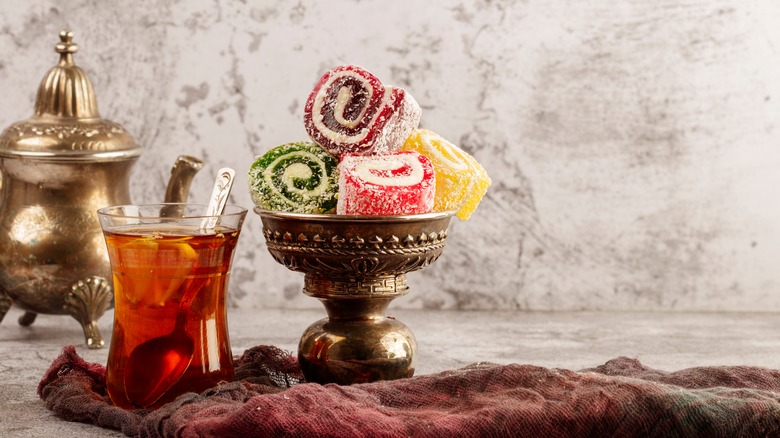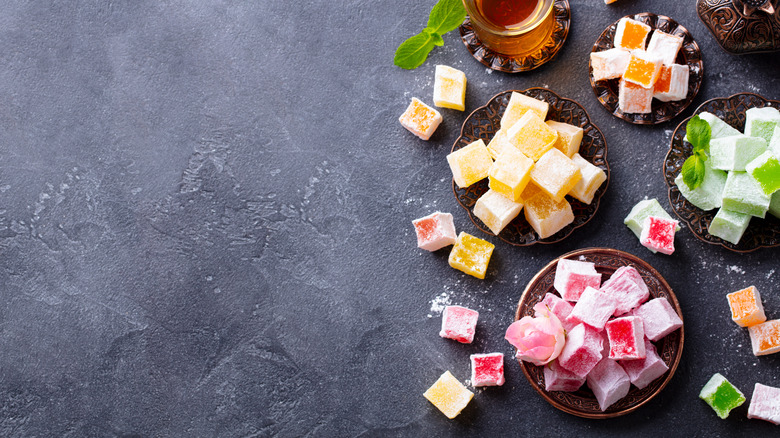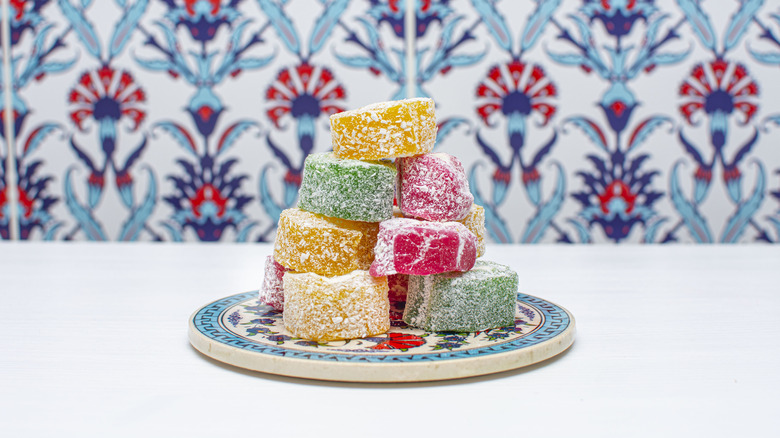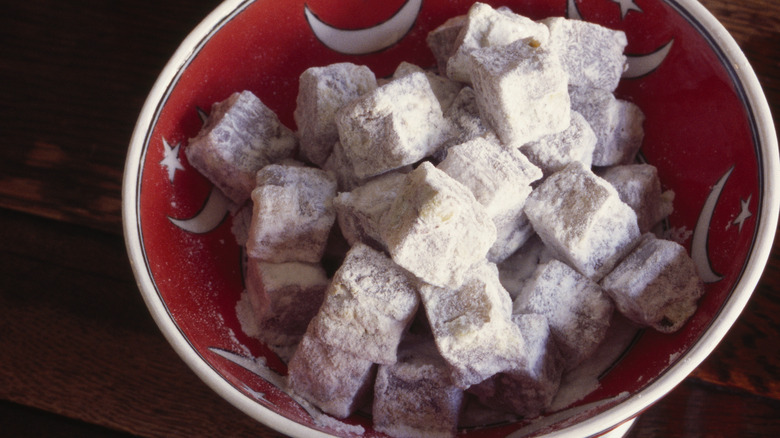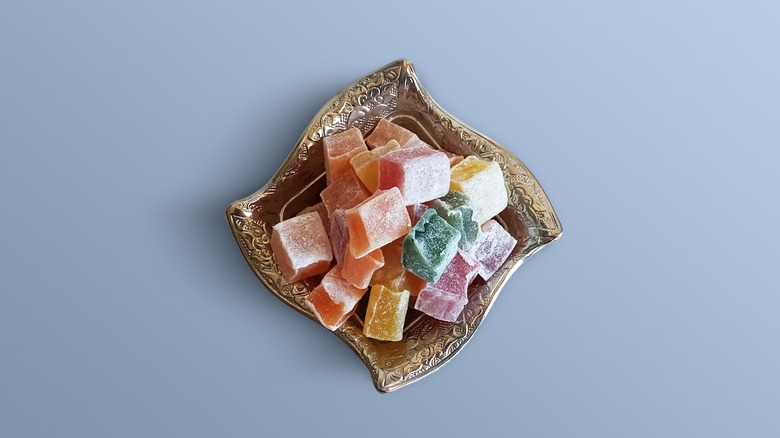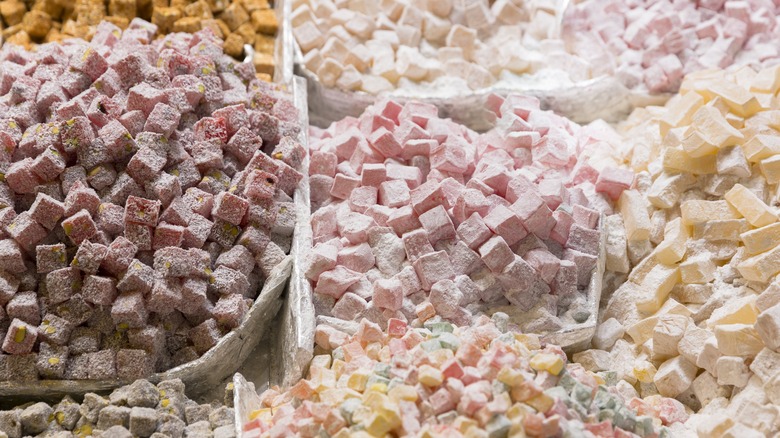What Exactly Is Turkish Delight?
When it comes to food, there are some things that simply have the ability to split the room. Think licorice, anchovies, blue cheese, olives, or vegemite. Whether you love it or hate it, those who love it can see no wrong, while those who hate can see no right. The same can be said for Turkish delight. Regardless of which side of the fence you permanently reside on, what exactly is Turkish delight?
Turkish delight – also referred to as Lokum – is a soft, sweet treat with a look and feel that resembles jelly. Often dusted with powdered sugar, it boasts floral flavors and fragrances and easily dissolves into a sticky mold of sweetness on the palate. Having come at a time when candy and other sweet treats were exclusively sweetened with honey or fruits, the use of refined sugar in Lokum revolutionized the confectionery scene after a traveler introduced it to England during the 1830s. Read on to find out more about its origins, fascinating facts, and some of the historical household names who were just as fond of it as those Turkish delight lovers who can see no wrong with it today.
Origin of Turkish delight
While it is not clear where in Turkey Turkish delight was first made, its origins date as far back as 500 years when it was enjoyed during the Ottoman Empire. Haci Bekir Effendi, who has often been referenced as the creator of the treat, was born in the northern region of Turkey in the city of Araç. He later moved to Istanbul, where he established the Haci Bekir shop in 1777. The shop has produced and sold Turkish delights for more than two centuries, and has earned Effendi praises as a true master of the Lokum (as it is still called in Turkey) craft.
Not only did he master the art of it, he is also credited as the creator of Turkish delight as we now know it. Located near the Yeni Cami (New Mosque), the Haci Bekir shop is now operated by sisters Hande Celalyan and Nazlı İmre. They are the fifth generation to take over the reins of the confectionery after their great-great-grandfather. Even though he created the business, his female descendants have continued to hold the reins over the family business for the last century. When Ali Muhiddin took over after his father, it was his mother Reşide who acted as his primary advisor, and so the effects rippled, right until the Celalyan uttered the words: "There is no difference between being a man or a woman as long as you're good at what you're doing."
Turkish delight originated from the word rahat-ul hulküm
While Turkish delight is commonly called Lokum among Turkish people, its lesser-known name is rahat-ul hulküm, which was the treat's first name. The word Lokum is derived from the Arabic al-lukum, which translates to "morsel" or "mouthful." Interestingly though, rahat-ul hulküm translates to "throat comfort" or "relieving throat." It is unclear why it was first called rahat-ul hulküm – perhaps an ode to its soft, jelly-like texture? Given the origins of the word Lokum, it is also unclear why the countrymen who created it called it Lokum.
Over time, after its name had morphed into Lokum, when it was first imported to England, there it arrived as "Lumps of Delight," and over time, "Turkish delight." One can safely assume that it was at the time, literally lumps of delight to English people who were learning about it for the first time. However, given its vast popularity among the Europeans, perhaps Turkish delight can at the very least, be regarded as a homage to the country that brought them – and the rest of the world – so much confectionery goodness.
How is Turkish Delight made?
The small number of ingredients used to make Turkish delight are not in any way an indicator of the ease with which it is made. In fact, it is nearly impossible for laymen to make it exactly as it was intended by its creators. In fact, beyond all the other steps involved, it requires two people to stir the starch; they must take turns and stir in exactly the same way, lest the consistency be ruined or the sugars crystallize. Once the paste has formed, it is poured onto powdered sugar-dusted wooden molds, and then onto marble molds, before it is cut into 3-centimeter strips and then into cubes using a special knife.
Even with detailed directions, traditional Turkish delight is difficult to make – more on that later. To make this Rose Turkish delight, you will need pantry staples: cornstarch, water, caster sugar, lemon juice, gelatin, rose water, food coloring, and powdered sugar. If you're simply keen on the sweetness and texture without the food coloring or the rosewater, you can opt for this Turkish delight recipe.
What does Turkish delight taste like?
For novices, Turkish delight can be likened to jelly candies or gumdrops. However, describing what it tastes like is a lot more complex than that. First, flavor profiles are highly dependent on the type and flavor of Turkish delight you are eating. For instance, plain Turkish delight won't necessarily be bursting with flavor. The texture will still be jelly-like, and it will still contain its customary sweetness, but you won't get any of the flavor or fragrance you would in other types.
The original Turkish delight, which is also the most popular, is flavored with rosewater. Not only will this give you a potent floral aroma, but it will also have the flavor to match. You may readily associate roses with perfume, however, the taste will not be as pungent as what you get when you accidentally taste a minuscule drop of perfume. Other floral flavors like orange blossom, lavender, and safflower will follow the rosewater in terms of aroma and flavor. Similarly, so too will those that are filled with nuts, fruits, and other flavors listed below. Ultimately, like any foods or confectioneries that may be unfamiliar to your palate, Turkish delight can be a bit of an acquired taste. It's simply a matter of how far you are willing to explore all the various flavors have to offer.
Types of Turkish delight
As the home of the delight, it goes without saying that you can find a wide selection of the sweets along the streets of Istanbul and Turkey. Per Eskapas, hundreds of variants are available but there are a select few that are listed among the most popular. There are those that pay homage to fresh fruits in the form of cherry, kiwi, lemon, orange, peach, strawberry, or various mixes of these. If you have a taste for spicier sweets, there's cinnamon, ginger, and clove. For those who enjoy the texture of nuts, there are peanut, walnut, almond, and even coconut and almond flavors; while more adventurous palates may relish coffee, bilberry, pomegranate, and chocolate flavors.
Other flavors that pair perfectly with Turkish delight include mint, lavender, apple, saffron, and safflower. If you're looking for something really special, there are several other types of Turkish delight. Among these are Lokum with Kaymak which incorporates cream into the recipe. Sultan Lokum includes Saponaria – otherwise known as soapwort, a perennial herb that flowers. Lokum from Bologna resembles chocolate bars in shape and usually contains dried fruits and nuts, while plain Lokum can be an exceptional treat for purists who enjoy their delights with no bells and whistles.
Turkish delight can be a fun addition to other desserts
Given its distinct flavor and jelly-like texture, Turkish delight can be a great addition to other desserts. Included among these additions and flavors is Turkish Delight Crème Brûlée. With the freshness of its raspberry flavor, adding Turkish delight to the classic French dessert injects a surprising tone of tart sweetness. Another rendition that is anchored in berries is Berry Cassata. Traditionally a Sicilian sponge cake that is layered with fruit juice, ricotta cheese, and candied or fresh fruit, Berry Cassata incorporates seasonal berries including strawberries, blackberries, cream, blocks of Turkish delight, and toasted pistachios for a bit of a crunch.
Another fun recipe is Turkish Filo Delight Cigars. If you delight in the nutty goodness of baklava, adding small cubes of Turkish delight to the layers of the famous Middle-Eastern pastry dessert is not only a surprising take on an old-time favorite but contrasts the nutty flavors of the dish with the tart sweetness of Turkish delight. For an extra indulgent treat, you might even add chocolate shavings. On the note of chocolate: for those who love a dose of cocoa, there's always the tried and true Rocky Road. Traditionally made using marshmallow pieces, candy, and nuts, incorporating pieces of Turkish delight amid all the other sweet treats can be a fun little twist. Other fun additions include pavlova, meringues, ice cream terrine, and even cookies! The possibilities here are truly endless.
Health benefits of Turkish delight
When it comes to sweet treats, one may not readily associate them with health benefits. However, depending on who you ask, Turkish delight boasts some of its own. While it is generally understood that the nutrition profile will shift depending on the type and ingredients of the Turkish delight, according to Ali Baba, there are seven main benefits that should be noted. First, it can act as a source of energy when you need a quick jolt – likely due to the sugar content. Secondly, it is widely accepted as an aid for people who have kidney disease. It is believed to assist the body in flushing out toxins, particularly when one has consumed large amounts of protein. In some parts of Anatolia, it seems to have been used as a wound care remedy. When mixed with citric acid, pistachios, and saffron, it is believed to help reduce acid in the stomach.
Other mixtures that are thought to have medicinal properties are coconut and hazelnuts. Together, these are thought to aid skin health. While its texture is thought to help in relieving stress – seemingly similar to squeezing a stress ball. Additionally, Turkish delight has also been purported to aid in the treatment of palatine tonsillitis. There are seemingly no scientific studies to support these health benefits claims, as such, it may be safer to conclude that they are best known and understood by the custodians of this delicious treat.
Turkish delight may have been C.S. Lewis' guilty pleasure
When C.S. Lewis' best-selling book "Chronicles of Narnia: The Lion, The Witch, and The Wardrobe" was adapted into a feature film, one of its more unexpected impacts on contemporary society was the surge in Turkish delight's popularity across the globe. The iconic shift begins when after magically appearing in the kingdom of the Snow Queen, Edmund names Turkish delight as the thing he most craves to eat. Just as quickly as the thought jumped into his mind, so too does a box of Turkish delight appear before him. So the story goes right until the sugary treat forms part of his betrayal of his siblings.
This has led many readers to believe that Turkish delight may have C.S. Lewis' guilty pleasure; that he too may have been able to relate to Edmund's insatiable taste for it. Among academics, the more important question here is why, of all the food and treats that could have been chosen, Turkish delight was the one Edmund chose. The answer may never be clear, but what is noteworthy, is that C.S. Lewis' descriptions alluded to the more traditional forms of Turkish delight. Moreso, the period in which the book was written was characterized by virtually nonexistent access to sweets treats. As such, it is not hard to believe that even a small piece of treat would be memorable to influence readers across the globe.
Turkish delight has never been successfully manufactured in Europe
Although early versions of Turkish delight were made using only a handful of flavorings — like almonds, musk, rose oil, and pistachios — the process of making has never been successfully replicated in Europe. Per JSTOR Daily, many European manufacturers tried and failed, only to present a range of explanations as to why they couldn't execute it. One attempt even resulted in the water being blamed! Having developed a fervent taste for the sweet, England started importing Turkish delight in 1861. It was known as "Lumps of Delight" at the time and garnered so much excitement among the English that it had a whole cartoon segment dedicated to its arrival in Punch magazine.
It soon gained enough traction that specialty shops of the closest knock-off versions began to pop up. With this came a range of flavors, including lemon, orange, and violet flavorings, and adding nuts, syrups, and chocolate. These were then packed in hexagon-shaped boxes that were lined with wax paper to keep the powdered sugar dusting on the candy intact. So the next time you open a box of the candy, remember that authentic Turkish delight is a well-kept secret.
Turkish delight won its first award at the Vienna Fair in 1873
Long before Turkish delight was hauling awards at international fairs, an unnamed traveler had merely had a few cases of the treat brought to Britain from his travels to Istanbul. It soon became popular among the British high-class people and the royals, as many of them began placing pieces of it in their silk handkerchiefs, which they would present to family and friends as gifts. Soon enough, the Haci Bekir sweet shop was not only being given a nod in literature and art societies, but the man himself went on to represent Turkey at a range of international fairs.
In 1873, his Turkish delight received a Silver medal at the Vienna Fair – the first of many awards to come, and a catapulting moment that grabbed the attention of the public. Over the years, Haci Bekir's Turkish delight went on to earn another silver medal at the Cologne Fair in 1888, and four gold medals at the Brussels Fair in 1897, the French Fair in 1906, the Paris Fair in 1930, and again at the Brussels Fair in 1930. It received the Nice Fair Medal of Honour in the same year and went on to earn the 1939 Merit Award at the New York Fair.
Pablo Picasso, Winston Churchill, and Napoleon used to eat Turkish delight
Besides C.S. Lewis and all the children across the world who became enamored with Turkish after meeting Edmund and the Snow Queen, there are other notable public figures who have been known to enjoy their fair share of Turkish delight. World-renowned Spanish painter Pablo Picasso apparently had some Turkish delight every day to boost his concentration and productivity. The former Emperor of France Napoleon Bonaparte seems to have also had a taste for the timeless treat. He was thought to especially favor Turkish delight with pistachio nuts.
Former British Prime Minister Winston Churchill was apparently also fond of Turkish delight. Like Napoleon, he too specifically enjoyed his Turkish delight filled with pistachios.
